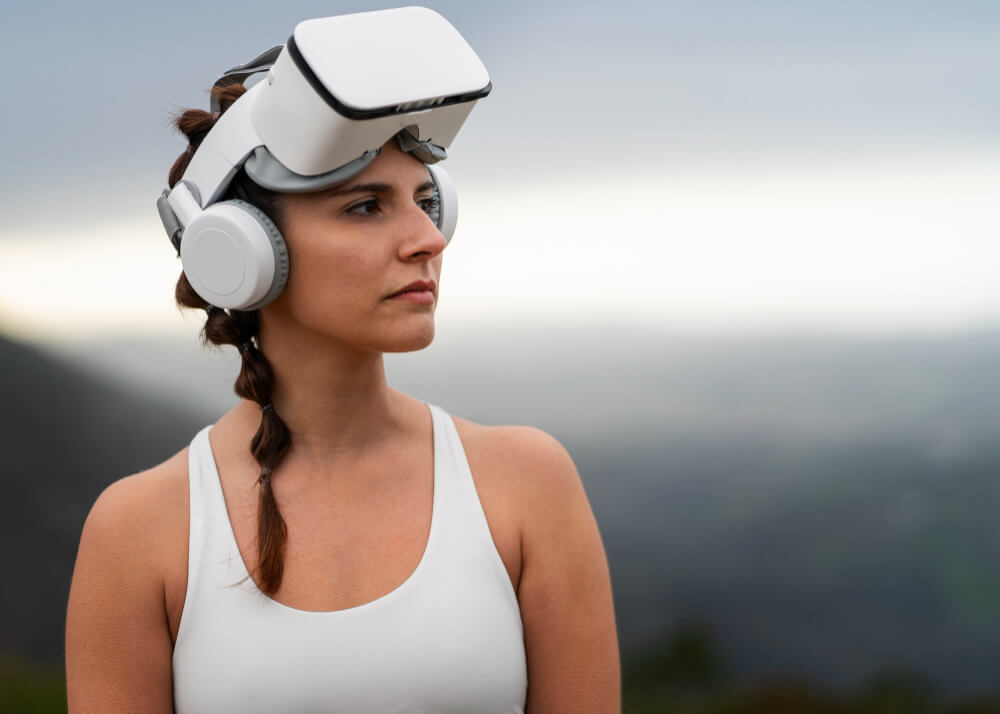
In today’s fast-paced world, the convergence of fashion and technology has sparked a revolution in wearable tech trends. From smart clothing that monitors health to sleek accessories blending style with functionality, the intersection of these two industries is reshaping how we interact with fashion and everyday technology. This blog post delves into the exciting realm of wearable technology, exploring its evolution, current trends, and prospects at the dynamic crossroads of fashion and technology.
Historical Context: The Evolution of Wearable Technology
The journey of wearable technology traces back to ancient times when rudimentary forms like the abacus ring were used for calculations. However, the modern concept began to take shape in the late 20th century with inventions like the calculator watch and the Walkman. These early devices laid the groundwork for today’s sophisticated wearables.
In the 21st century, advancements in miniaturization, connectivity, and sensor technology propelled wearable tech into the mainstream. The introduction of fitness trackers and smartwatches marked a significant shift, blending utility with fashion. Gradually, wearable tech expanded beyond mere functionality to encompass style, paving the way for innovations like smart clothing embedded with sensors and fabrics.
Cultural and societal shifts also played a crucial role in shaping wearable technology trends. The rise of the health and wellness movement spurred the development of fitness-centric wearables, while the growing emphasis on personalization fueled demand for customizable accessories.
As wearable technology continues to evolve, its integration into fashion becomes increasingly seamless, offering endless possibilities for enhancing both form and function.
Early examples of wearable tech and their functionalities
- Abacus Ring: Dating back to ancient times, the abacus ring was used for basic calculations, demonstrating an early form of wearable technology.
- Pocket Watches: In the 16th century, pocket watches emerged as portable timekeeping devices, combining functionality with fashion.
- Calculator Watch: Introduced in the 1970s, the calculator watch integrated basic arithmetic functions into a wristwatch, blending utility with convenience.
Walkman: In the 1980s, the Walkman revolutionized portable music listening, allowing users to carry their favorite tunes wherever they went.
Milestones in the intersection of fashion and technology
- Introduction of the iPod: Apple’s iPod, released in 2001, not only transformed the music industry but also showcased the potential for technology to merge seamlessly with fashion.
- Launch of Fitbit: The release of Fitbit in 2008 marked a pivotal moment in wearable technology, introducing the concept of fitness tracking in a stylish, wearable form.
- Collaboration between Fashion Designers and Tech Companies: Collaborations between fashion designers and tech companies, such as the partnership between Google and Diane von Furstenberg for Google Glass, highlighted the fusion of technology and high fashion.
- Rise of Smart Clothing: The emergence of smart clothing, equipped with sensors for health monitoring and performance enhancement, represents a significant milestone in the convergence of fashion and technology.
Influence of cultural and societal shifts on wearable tech trends
- Health and Wellness Movement: The increasing focus on health and wellness has driven the demand for fitness-centric wearables, such as activity trackers and smartwatches, that monitor physical activity and promote healthy lifestyles.
- Personalization and Self-Expression: The desire for personalized experiences and self-expression has fueled the development of customizable wearable accessories, allowing individuals to showcase their unique styles and preferences.
- Sustainability and Ethical Considerations: Growing awareness of environmental and ethical issues has prompted a shift towards sustainable and ethically sourced materials in wearable technology, reflecting changing consumer values and priorities.
- Technological Advancements: Rapid advancements in miniaturization, connectivity, and sensor technology have facilitated the integration of technology into fashion, enabling the creation of innovative wearable tech solutions that enhance both form and function.
Current Trends in Wearable Technology
Smart Clothing: Integration of sensors and fabrics for health monitoring and performance enhancement
Examples of smart clothing innovations:
Biometric shirts are capable of tracking heart rate, respiratory rate, and calorie expenditure during workouts.
Smart socks equipped with pressure sensors to analyze gait and prevent injuries during running.
Impact on fitness, healthcare, and lifestyle industries:
Smart clothing is revolutionizing fitness routines by providing real-time feedback on performance and improving training efficiency.
In the healthcare sector, smart garments offer remote patient monitoring capabilities, enhancing the management of chronic conditions and post-operative care.
Smart clothing is also making waves in the fashion industry, with designers incorporating technology into their collections to create interactive and futuristic apparel.
Wearable Accessories: Fashion-forward gadgets enhancing style and functionality
Smartwatches, smart glasses, and other wearable accessories:
Smartwatches have evolved beyond basic timekeeping to become multifunctional devices capable of monitoring health metrics, receiving notifications, and even making payments.
Smart glasses incorporate augmented reality (AR) technology to overlay digital information onto the wearer’s field of view, revolutionizing industries such as manufacturing, healthcare, and retail.
Role of aesthetics and design in wearable tech adoption:
Fashion-forward designs and customizable features are driving the adoption of wearable accessories among consumers who value both style and functionality.
Collaborations between tech companies and fashion brands are blurring the lines between traditional accessories and cutting-edge technology, appealing to a broader audience of fashion-conscious consumers.
Augmented Reality (AR) and Virtual Reality (VR) in Fashion
Application of AR/VR in virtual try-on experiences:
AR-powered virtual fitting rooms allow consumers to try on clothing and accessories virtually, enhancing the online shopping experience and reducing returns.
VR technology is being used to create immersive fashion shows and virtual shopping environments, enabling brands to engage with consumers in new and innovative ways.
Blurring the lines between physical and digital fashion experiences:
AR and VR are transforming the way consumers interact with fashion, bridging the gap between the physical and digital worlds and offering endless possibilities for creative expression and exploration.
As AR and VR technology continues to evolve, the boundaries between traditional retail and e-commerce are becoming increasingly blurred, paving the way for a new era of immersive and interactive fashion experiences.
Sustainability and Ethical Considerations
Environmental impact of wearable technology production and disposal
- Lifecycle Analysis: Assessing the environmental impact of wearable tech, from raw material extraction to manufacturing, distribution, and disposal.
- Electronic Waste: Addressing the growing concern of electronic waste generated by obsolete or discarded wearable devices and exploring sustainable disposal and recycling solutions.
- Sustainable Materials: Embracing eco-friendly materials and production processes, such as recycled plastics, organic textiles, and biodegradable components, to minimize environmental footprint.
Ethical concerns regarding data privacy and security in wearable devices
- Data Collection and Privacy Policies: Examining the collection and use of personal data by wearable devices and ensuring transparent privacy policies to protect user rights and confidentiality.
- Security Measures: Implementing robust security measures, such as encryption protocols and access controls, to safeguard sensitive information from unauthorized access and cyber threats.
- User Consent and Control: Empowering users with the ability to control their data and providing clear opt-in/opt-out mechanisms for data sharing and usage.
Initiatives towards sustainable and ethical wearable tech solutions
- Corporate Responsibility: Encouraging wearable tech companies to adopt sustainable and ethical business practices, including fair labor standards, supply chain transparency, and social responsibility initiatives.
- Certification and Standards: Establishing industry-wide certification programs and standards for sustainable and ethical wearable technology, similar to certifications for organic products or fair trade practices.
- Consumer Education and Awareness: Educating consumers about the environmental and ethical implications of wearable technology and promoting responsible purchasing decisions that prioritize sustainability and ethical considerations.
Future Directions: Emerging Technologies and Innovations
Predictive analytics and AI-driven personalization in fashion
- Data-driven Insights: Leveraging big data and machine learning algorithms to analyze consumer preferences, trends, and behavior, enabling predictive analytics for fashion forecasting and inventory management.
- Personalized Recommendations: Harnessing artificial intelligence to deliver personalized shopping experiences, with tailored product recommendations, sizing suggestions, and styling advice based on individual preferences and past interactions.
Integration of biometric data for customized user experiences
- Biometric Sensors: Embedding biometric sensors into wearable devices to capture physiological data, such as heart rate, skin temperature, and stress levels, for personalized health and wellness insights.
- Adaptive Technology: Utilizing biometric feedback to dynamically adjust wearable tech settings, such as adjusting lighting or temperature in smart clothing based on the wearer’s comfort and preferences.
Collaborations between fashion designers and tech companies for groundbreaking innovations
- Cross-Industry Partnerships: Fostering collaborations between fashion designers, engineers, and tech companies to push the boundaries of wearable technology, creating innovative products that seamlessly blend style and functionality.
- Co-Creation Workshops: Hosting co-creation workshops and hackathons to encourage interdisciplinary collaboration and ideation, sparking creativity and driving the development of new wearable tech concepts and prototypes.
Challenges and Opportunities
Technical limitations and barriers to mass adoption
- Battery Life: Addressing the challenge of limited battery life in wearable devices, which can hinder user experience and adoption rates.
- Size and Form Factor: Overcoming constraints related to size, weight, and comfort to design wearable tech that seamlessly integrates into everyday attire without compromising style or functionality.
- Connectivity Issues: Resolving connectivity issues, such as unstable Bluetooth connections or limited network coverage, to ensure reliable communication between wearable devices and companion apps or services.
Market dynamics and consumer acceptance of wearable tech
- Cost-Benefit Analysis: Balancing the cost of wearable technology with perceived benefits and value propositions to appeal to a broad spectrum of consumers across different socioeconomic backgrounds.
- Design and Aesthetics: Meeting consumer expectations for fashionable and aesthetically pleasing wearable devices that complement personal style preferences and enhance overall appearance.
- User Experience: Improving user experience through intuitive interfaces, seamless integration with other devices and platforms, and responsive customer support to enhance satisfaction and encourage repeat usage.
Potential for industry collaboration and interdisciplinary research
- Siloed Development: Breaking down silos between fashion and technology industries to foster collaboration and knowledge sharing, driving innovation and cross-pollination of ideas.
- Research and Development: Investing in interdisciplinary research and development initiatives to explore new materials, technologies, and design concepts that push the boundaries of wearable technology.
- Regulatory Compliance: Navigating regulatory frameworks and standards, such as data privacy regulations and product safety certifications, to ensure compliance and mitigate legal and reputational risks.
Conclusion
The fusion of fashion and technology in wearable tech represents a dynamic intersection that continues to evolve and shape the way we interact with clothing, accessories, and everyday gadgets. From smart clothing that monitors our health to augmented reality experiences that blur the lines between physical and digital fashion, the possibilities are endless.
As we look to the future, it’s clear that wearable technology will play an increasingly integral role in our lives, offering personalized experiences, enhancing functionality, and driving innovation across industries. However, to realize the full potential of wearable tech, we must navigate challenges such as technical limitations, market dynamics, and ethical considerations with diligence and creativity.






